NASA honors the Native American Navajo language through the names of different features found by the Perseverance on Mars, starting with the rock named "Máaz" - Navajo for "Mars."
After the Perseverance rover has successfully landed on the Red Planet last February 18, it has declared Máaz to be the "first feature of scientific interest" currently on the rover's sights. The team in charge of the Perseverance rover is working together with the Navajo Nation Office of the President and Vice President. Together, the two agencies are naming the features found on the Martian surface using words from the Navajo language.

This rock, called “Máaz” (the Navajo word for “Mars”), is the first feature of scientific interest to be studied by NASA’s Perseverance Mars rover.
ALSO READ: Viral Mars Perseverance Rover Video With Sound Is Fake! Here's Why
Using the Navajo Language for Martian Features
Additionally, NASA mission scientists have worked with Navajo, or Diné, team member Aaron Yazzie - who served as an engineer for the Mars 2020 mission at the NASA Jet Propulsion Laboratory in California - to seek the permission of the Navajo Nation in naming the Martian surface features. Aaron Yazzie also built the drill bits on the Perseverance which will be used to break down rocks and collect samples.
NASA now has a roster of 50 Navajo language words for future finds on Mars for starters, provided by Navajo Nation President Jonathan Nez, Vice President Myron Lizer, and their respective advisors. Perseverance, the name of the rover, has been translated into "Ha'ahóni."
"The partnership that the Nez-Lizer Administration has built with NASA will help to revitalize our Navajo language," said President Nez in a NASA release. He adds their hope in having their language being used in the Perseverance mission will inspire more of the Navajo youth to "understand the importance and the significance of learning our language."
President Nez added: "Our words were used to help win World War II, and now we are helping to navigate and learn more about the planet Mars." Navajo code talkers - Navajo men who created a code based on their complex and unwritten language - provided a strategic advantage to Allied forces in the World War II through an error-free, fast, and virtually unbreakable code.
Teaching Perseverance Navajo and Naming Martian Features
Perseverance was also "taught" the Navajo language, which it will use once it recognizes Martian landmarks. A challenging aspect of this is that the accent marks available in the English language, used to identify unique intonations of the Navajo language, are not readable in the computer language used by the Mars rover. Yazzie shared that they had to come up with translations "that best resemble Navajo spellings," and that the mission team will be using the basic English letters without special characters or accent marks to represent Navajo words.
NASA explains that surface missions name landmarks to provide the mission team a more common way to refer to geologic features of interest - rocks, soils, patches of land. These "nicknames" are different from the official designations provided by the International Astronomical Union for planetary features, being used mostly by the NASA team as informal references.
Furthermore, the Jezero Crater site where Perseverance landed has been divided into quadrangles roughly one square mile each. Each quadrangle is named after national parks on Earth with similar features. The specific quad where Perseverance landed was named after the Arizona Canyon de Chelly National Monument, right at the heart of the Navajo Nation.
RELATED ARTICLE: Siberians and Native Americans Related? Recent Discovery Shows Oldest DNA Link
Check out more news and information about Perseverance in Science Times.



![Earth's Quasi-Moon Kamo‘oalewa Could Originate From Lunar Surface Not Asteroid Belt [Study]](https://1721181113.rsc.cdn77.org/data/thumbs/full/53275/89/56/50/40/earths-quasi-moon-kamo-oalewa-could-originate-from-lunar-surface-not-asteroid-belt-study.png)










